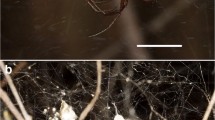Summary
Females of the solitary eumenid wasps Ancistrocerus adiabatus and Euodynerus foraminatus control the adult size of their offspring by the amount of food provded to the larvae. For both species, larger females provision more offspring and collect more food than smaller females. Males of E. foraminatus, upon emergence as adults, fight for control of the nest area. The winning brother remains at the nest and mates with his sisters as they emerge several days later. Males of A. adiabatus are not as agonistic as males of E. foraminatus so that a number of males may remain near the natal nest. When females nest near each other, male-male interactions increase, and the likelihood of sibling mating decreases. Under conditions of clumped nesting, females make larger offspring and invest more in males than when nesting in isolation.
Similar content being viewed by others
References
Bodmer WF, Edwards AWF (1960) Natural selection and the sex ratio. Ann Hum Genet 24:239–244
Brockelman WY (1975) Competition, the fitness of offspring and optimal clutch size. Am Nat 109:677–699
Coville RF, Coville, PL (1980) Nesting biology and male behavior of Trypoxylon (Trypargilum) tenoctitlan in Costa Rica (Hymenoperta: Sphecidae). Ann Entomol Soc Am 73:110–119
Cowan DP (1978) Behavior, inbreeding, and parental investment in solitary eumenid wasps (Hymenoptera: Vespidae). PhD thesis, The University of Michigan
Cowan DP (1979) Sibling matings in a hunting wasp: adaptive inbreeding? Science 205:1403–1405
Fisher RL (1958) The genitcal theory of natural selection. Dover, New York
Hamilton WD (1967) Extraordinary sex ratios. Science 156:477–488
Hamilton WD (1979) Wingless and fighting males in fig wasps and other insects. In: Blum MS, Blum NA (eds) Sexual selection and reproductive competition in insects. Academic Press, New York, pp 167–220
Holmes H (1970) Alteration of sex ratio in the parasitic wasp Nasonia vitripennis. PhD Thesis, University of Massachusetts
Krombein KV (1967) Tran-nesting wasps and bees: life histories, nests, and associates. Smithsonian Press, Washington, DC
Pianka ER (1976) Natural selection of optimal reproductive tactics. Am Zool 16:775–784
Rau P, Rau N (1918) Wasp studies afield. Princeton
Trivers RL, Hare H (1976) Haplodiploidy and the evolution of the social insects. Science 191:249–263
Werren JH (1980) Sex ratio adaptations to local mate competition in a parasitic wasp. Science 208:1157–1159
Wylie HG (1966) Some mechanisms that affect the sex ratio of Nasonia vitripennis (Walk) (Hymenoptera: Pteromalidae) reared from superparasitized housefly pupae. Can Entomol 98:645–653
Author information
Authors and Affiliations
Rights and permissions
About this article
Cite this article
Cowan, D.P. Parental investment in two solitary wasps Ancistrocerus adiabatus and Euodynerus foraminatus (Eumenidae: Hymenoptera). Behav Ecol Sociobiol 9, 95–102 (1981). https://doi.org/10.1007/BF00293580
Received:
Accepted:
Issue Date:
DOI: https://doi.org/10.1007/BF00293580




